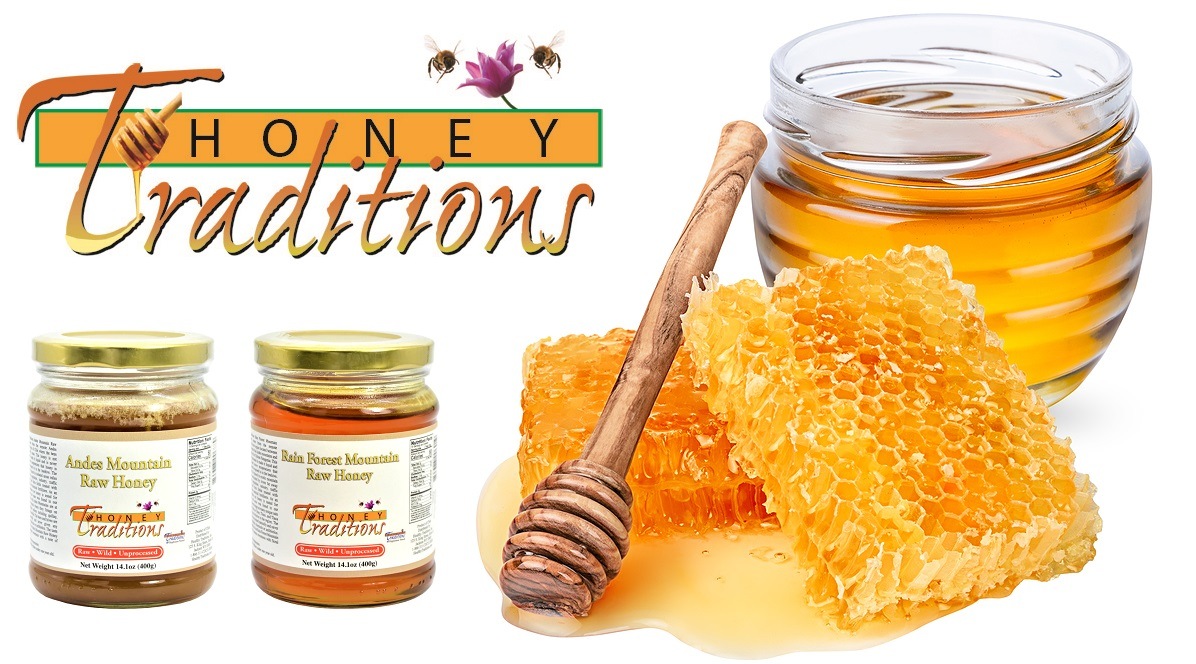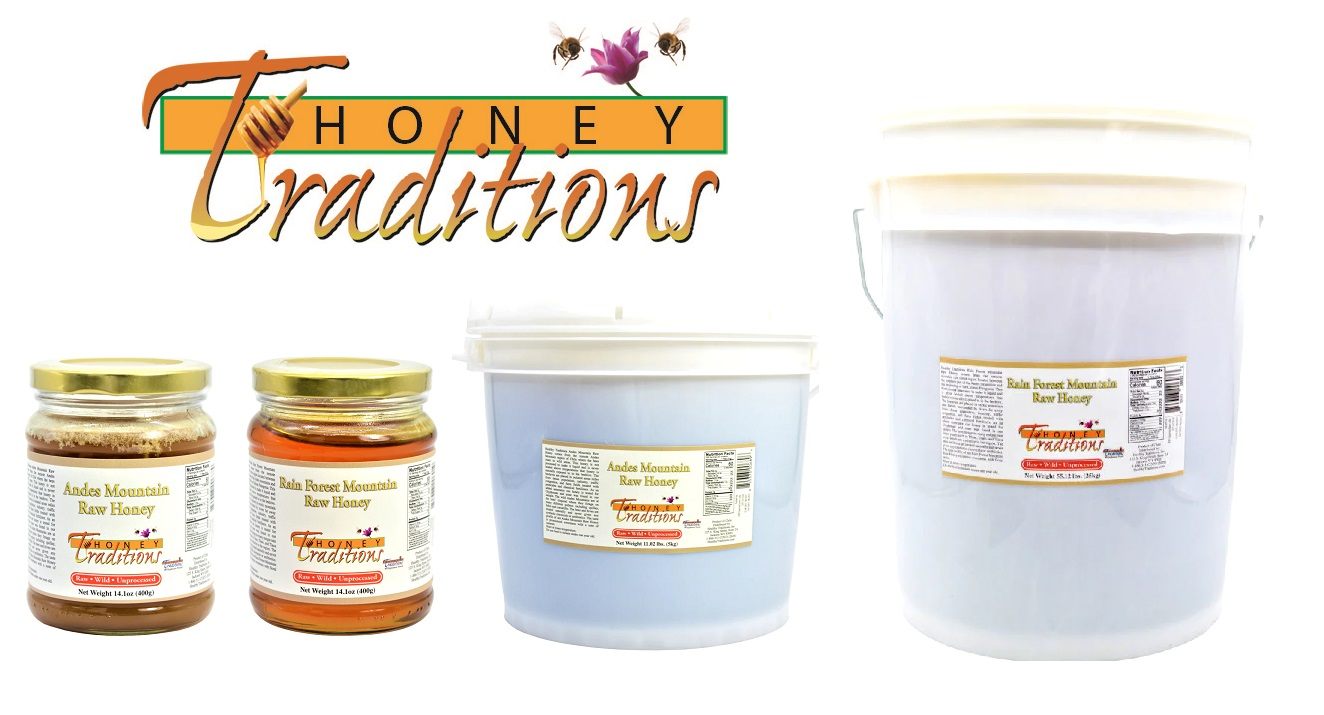
by Brian Shilhavy
Editor, Health Impact News
Honey is one of nature’s most perfect and beneficial foods. The documented research on the incredible health benefits of honey is truly astounding. If you type in the search term “honey” in the National Library of Medicine on the NIH Government website, you will get 15,480 results from peer-reviewed medical journals.
It is the ONLY sweetener on the market that you can purchase that is a complete, whole food, as opposed to granulated sugar which is an extract from either a grass (sugar cane), or from beets (sugar beets).
But purchasing real, pure, unadulterated raw honey that is not contaminated with herbicides or pesticides, is another matter altogether. Testing done in 2011 on grocery store honey showed that up to 80% of the honey sold in grocery stores is adulterated and even fake, much of it imported from China illegally. (Source.)
I know for a fact that this is true, because my company, Healthy Traditions, has been importing high quality pure honey from outside the United States for more than a decade, and while we do NOT import honey from China, every single shipment of honey that we have imported goes through an FDA hold to ensure that it is not “honey” that originated from China and is relabeled. It takes us more time to get honey across the border than any other product we import.
Honey that is produced in the U.S. and Canada is mostly a by-product of professional bee keepers who make their primary income from leasing out their bees to pollinate crops in commercial agriculture, which are heavily treated with herbicides and pesticides, and the resulting honey from these bees is just a by-product of these commercial bee operations, and that includes most “local” honeys.
So what I am going to do in this article is educate you on the numerous health benefits of raw, pure honey, and the lucrative bee and honey operations in commercial agriculture, so that you can be an informed consumer and look for pure, raw honey that is not contaminated.
Pure raw honey has been proven through numerous studies to be more effective than drugs in treating many diseases, and since honey can be stored indefinitely and tends to improve with age, like fine wines, this is a food that you want in your long-term food storage plans, and you want honey that heals, not honey that is contaminated, or “honey” that is not even real honey at all.
Honey is the Only Sweetener You Should be Using if You Want Optimal Health
As I wrote in the intro, honey is the only sweetener you can purchase in the market that is an unprocessed whole food, where you can consume it in its natural form as found in nature inside the bee hive.
Here is an excerpt from the article titled “Why You Should Ditch Sugar In Favor of Honey” written by Sayer Ji of GreenMedInfo.com back in 2012:
While honey and sugar share similar degrees of sweetness, the differences in the way our bodies respond to them are profound.
Technically, honey and sugar (sucrose) both exist because they are food for their respective species.
In the case of sugarcane, a member of the the grass family (Poaceae) which includes wheat, maize and rice, sucrose provides energy for its leaves and is an easily transportable source of energy for other parts of the plant, such as the root, that do not produce their own energy.
Honey, of course, is produced by bees from the nectar of flowers solely for the purpose of food.
Beyond this obvious similarity, the differences between honey and sugar, however, are much more profound.
First, honey is a whole food and sucrose is not. In other words, sucrose is an isolate – technically only one chemical compound – lifted from a background of hundreds of other components within the whole plant, whereas honey is composed of an equally complex array of compounds, many of which are well-known (including macronutrients and micronutrients, enzymes, probiotics and prebiotics, etc.), others whose role is still completely a mystery.
Even the “sugar” in honey, which we might mistakenly equate (due to caloric and nutrient classification equivalencies) to the “sugar” from sugarcane, is a complex mixture of the monosacharrides (one-sugars) glucose and fructose, and at least 25 different oligosaccharides (which are sugars composed of between two to ten monosaccharides linked together), including small amounts of the disacchardide sucrose, as well as trisaccharides (three-sugars) like melezitose and erlose.[i]
Interestingly, if you were to isolate out the fructose from honey, and consume it in isolation in American-size doses (over two ounces a day), it would likely contribute to over 70 fructose-induced adverse health effects; primarily insulin resistance, fatty liver, obesity, hypertension and elevated blood sugar. But place that fructose back into the complex nestled background of nutrient chemistries we call honey, and the fructose loses its monochemical malignancy to our health.
Food is the ultimate delivery system for nutrition. Reduce whole foods to parts, and then concentrate and consume them excessively, and you have the recipe for a health disaster that we can see all around us today in the simultaneously overnourished/malnourished masses who still think a ‘calorie is a calorie,’ and a ‘carb is a carb,’ without realizing that the qualitative differences are so profound that one literally heals, while the other literally kills.
For those skeptics who consider this reflection on the differences between honey and sugar mere theory, there is now plenty of clinical research confirming their significant differences.
A double-blind, randomized clinical study titled, “Effect of honey versus sucrose on appetite, appetite-regulating hormones, and postmeal thermogenesis,” published in 2010 in the Journal of the American College of Nutrition, compared the effects of honey or sugar on appetite hormones (ghrelin, peptide YY) and glycemic and thermic effects after a meal, in 14 healthy, nonobese women.
The researchers found that the group given 450 calorie (kcal) honey in their breakfasts had “A blunted glycemic response may be beneficial for reducing glucose intolerance,” and saw positive modulation of appetite hormones, i.e. delayed the postprandial ghrelin response and enhanced total peptide YY levels.[iii]
Another study published in Journal of Medical Food in 2004, which compared honey to dextrose and sucrose, found that natural honey was capable of lowering plasma glucose, C-reactive protein, homocysteine in healthy, diabetic and hyperlipidemic subjects.[iv]
Animal research also confirms that, when compared to sucrose, honey is more effective at promoting lower weight gain, adiposity (fat accumulation), and triglycerides.[v]
References
[i] Stefan Bogdanov, Tomislav Jurendic, Robert Sieber, Peter Gallmann, Honey for Nutrition and Health: A Review, J Am Coll Nutr December 2008 vol. 27 no. 6 677-689
[ii][ii] Crane E: History of honey. In Crane E (ed):”Honey, A Comprehensive Survey.” London: William Heinemann, pp439– 488,1975 .
[iii] D Enette Larson-Meyer, Kentz S Willis, Lindsey M Willis, Kathleen J Austin, Ann Marie Hart, Ashley B Breton, Brenda M Alexander. Effect of honey versus sucrose on appetite, appetite-regulating hormones, and postmeal thermogenesis. J Am Coll Nutr. 2010 Oct ;29(5):482-93. PMID: 21504975
[iv] Noori S Al-Waili . Natural honey lowers plasma glucose, C-reactive protein, homocysteine, and blood lipids in healthy, diabetic, and hyperlipidemic subjects: comparison with dextrose and sucrose. J Med Food. 2004 ;7(1):100-7. PMID: 15117561
[v] Tricia M Nemoseck, Erin G Carmody, Allison Furchner-Evanson, Marsa Gleason, Amy Li, Hayley Potter, Lauren M Rezende, Kelly J Lane, Mark Kern. Honey promotes lower weight gain, adiposity, and triglycerides than sucrose in rats. Nutr Res. 2011 Jan ;31(1):55-60. PMID: 21310307
It does take some practice and experience in replacing sugar with honey in recipes, and as our family embarked on this process several years ago, I had my daughter write an article on her experiences in how to replace sugar in recipes with honey:
How to Use Raw Honey in Place of Sugar in Baking
Pure Raw Honey’s Numerous Health Benefits
As I mentioned in the intro, the U.S. Government’s website PubMed currently has over 15,000 peer-reviewed studies on honey.
GreenMedinfo.com has 276 abstracts on some of the more amazing studies on honey’s health benefits.
Here are a few articles we have published on honey’s amazing health benefits over the past decade:
Honey Out-Performs Antibiotics in Fighting Superbugs
Excerpt:
Honey has been used for centuries to counteract infections, but until recently few realized just how antibiotic honey was. There is overwhelming evidence from research showing that honey beats some pharmaceutical antibiotics when it comes to a variety of superbugs.
Honey: A Powerful Anti-Cancer Agent
Excerpt:
Most of us know honey as a sweet treat, but few are aware of its powerful cancer killing properties. Honey is a superlative healing food. We know it has over 69 health benefits, as confirmed by the biomedical literature itself. But did you know it could be of profound benefit in diseases as life threatening and seemingly incurable as cancer?
Phenolic Compounds and Enzymatic Activity in Raw Honey Positively Affect Oxidative Stress and Bone Density
Excerpt:
Much of the research available to us today regarding modern-day diseases points to oxidative stress and inflammation. One of the easiest ways to combat this modern-day problem affecting our health is to replace refined sugars in your diet with honey. Let’s take a look at how making this one simple change in our diet, to using honey instead of refined sugar, can have tremendous health benefits.
Honey Heals Chronic Dandruff, Scaly, Itchy Scalp (Seborrheic Dermatitis)
Excerpt:
Amazingly, something as simple as crude honey has been found to alleviate an embarrassing scalp condition that most body care products and drugs can’t even make a dent in, like chronic dandruff and seborrheic dermatitis.
We should not be surprised by these remarkable results. Honey has been considered one of nature’s most remarkable gifts to mankind since ancient Indian (vedic) civilization. In ancient Egyptian culture honey was the most popular drug mentioned: 500 times in 900 remedies.
Honey Plus Coffee Beats Steroid For Treating Cough
Excerpt:
A remarkable new study looking at natural alternatives to medications found that compared to a systemic steroid, a combination of honey and coffee was superior in reducing symptoms associated with a post-infectious cough (PPC). PPC is a cough that remains after a common cold or an upper respiratory tract infection for more than three weeks, and in some cases as long as several months. Conventional treatment may involve any number of powerful drugs, many of which have serious side effects, including codeine and dextromethorphan (so-called centrally acting antitussives), antihistamines, narcotics, and bronchodilators.
Given the relative safety and superior effectiveness of honey plus coffee versus prednisolone, this study adds to a growing body of biomedical research indicating that natural substances, including spices, vitamins and foods, are often superior in efficacy to synthetic drugs while often maintaining far higher levels of safety relative to them.
A search for “honey” in the English translation of the Bible finds about 40 verses where honey is mentioned. It is used in the Old Testament to describe the “Promised Land” that God was leading the Israelites to:
And I have promised to bring you up out of your misery in Egypt into the land of the Canaanites, Hittites, Amorites, Perizzites, Hivites and Jebusites–a land flowing with milk and honey. (Exodus 3:17)
In I Samuel we read that Jonathan, the son of King Saul, during a battle found some honey in the woods while pursuing his enemies, and after eating some his “eyes brightened.”
… he reached out the end of the staff that was in his hand and dipped it into the honeycomb. He raised his hand to his mouth, and his eyes brightened. (1 Samuel 14:27)
In the book of Proverbs, one is encouraged to eat honey:
Eat honey, my son, for it is good; honey from the comb is sweet to your taste. (Proverbs 24:13)
In the New Testament, John the Baptist, the cousin of Jesus Christ who spent most of his adult life living in the desert, ate wild honey and locusts:
John’s clothes were made of camel’s hair, and he had a leather belt around his waist. His food was locusts and wild honey. (Matthew 3:4)
Understanding Commercial Agriculture and the Honey Market in North America
As I mentioned in the intro, most of the honey sold in North America is a by-product of the commercial bee industry. Professional bee keepers transport their bees all across North America to pollinate crops in commercial agriculture, which is their main business, and then have to sell the by-product, which is honey.
Most of the bees in North America go to California once a year to pollinate their almond trees, as almonds are California’s #1 agricultural product, a $4 billion dollar industry.
Because of the heavy use of pesticides and herbicides, this has put increasing pressure on the bee supply. We covered this issue in 2014:
Are California Almonds Destroying the U.S. Bee Supply?
Excerpts:
80% of the world’s almonds come from California’s Central Valley. Almonds are the #1 agricultural crop grown in California. It is a $4 billion industry.
There’s just one problem with this huge industrial agricultural system: it needs bees to pollinate their almond trees every spring. Therefore, every year, much of the nation’s bee supply, as well as Canada’s, is transported to California to pollinate the almond trees. This year, it may be that nearly 100% of the U.S. bee supply will go to California to pollinate the almond trees.
Last year, many of the bee hives from the northern climates arrived dead, forcing almond growers to find other sources of bees. Many could not find bees at any cost, as even bees used in the citrus crops of Florida were transported to California to try to meet the demand. The almond industry barely survived last year.
According to an article published recently by Paul Driessen of the DailyCaller, the California almond industry is putting pressure on the northern climate bee keepers to hurry bees to California, at great risk to the bees:
A major problem is that bee colonies, especially those from northern states, lack sufficient time to emerge from their heat-conserving winter cluster. To meet this challenge, some beekeepers maintain 20,000 to 30,000 hives. Each one requires careful inspection for devastating diseases and parasites – a meticulous task impractical at such a scale.
Making their task more difficult is the fact that beekeepers are trying to impose large-scale agricultural methods on an animal whose husbandry practices have been virtually unchanged since the nineteenth century.
Unfortunately, almond demand for bees has led many commercial beekeepers to put their stocks at risk, because the payoff can amount to half an individual keeper’s yearly profit. (Source.)
Beekeeper Ed Colby described the consequences of bringing together bees from all around the United States and letting them mingle together. The result is “bees come back from California loaded with mites and every other disease you can think of. … But the upside is they pay you money, and it’s good money.”
Is it a sustainable form of agriculture to transport 1.5 million honey bee hives to California from as far away as Florida to pollinate the almond groves each year? This style of agriculture produces a large crop of nuts, but is this good for the bees, the nutritional quality of the almonds, and the health of consumers?
As these bees pollinate the almond industry in California and other commercial agricultural products in North America, they produce honey which the bee keepers then sell to commodity brokers and that is where much of the nation’s honey comes from.
In recent years scientists have become concerned about the nation’s bee supply, so they began testing the honey to see if the chemicals sprayed on the crops that the bees are pollinating passed on to the bees by studying the honey they produced.
They weren’t so concerned about the contamination of the nation’s honey supply, but much more concerned about the bee populations, because this has a direct impact on growing commercial crops, like the almonds in California.
One of those studies conducted in Canada found that 99% of honey samples tested were contaminated with the herbicide glyphosate, the active ingredient in RoundUp and the #1 herbicide in the world that is now linked to cancer. Other studies also confirmed this problem.
Here is an excerpt from a report I published in 2019:
A recent study published in the journal Food Additives & Contaminants analyzed 200 random samples of honey in Canada. The study was conducted by the Agri-Food Laboratories, Alberta Agriculture and Forestry, in Edmonton, Alberta, Canada.
Their analysis found that almost 99% of the honey samples analyzed were contaminated with the herbicide glyphosate, the active ingredient in RoundUp that has been linked to cancer.
Two hundred randomly chosen honey samples, which were submitted to our laboratory for other testing, were analysed using the online SPE-LCMS/MS method to obtain information regarding baseline levels of glyphosate, its main degradation product AMPA, and the other acidic herbicide, glufosinate.
Glyphosate was detected in almost all honey samples analysed with 197 out of 200 samples (98.5%) having residues… (Source.)
Canada is not the Only Place with Glyphosate-Contaminated Honey
In a study published in 2014 in the Journal of Environmental & Analytical Toxicology titled “Survey of Glyphosate Residues in Honey, Corn and Soy Products,” researchers analyzed food samples purchased in stores in the Philadelphia area, including honey, both organic honey and non-organic honey.
Their analysis found:
Of the sixty-nine honey samples analyzed, forty-one samples, or fifty-nine percent (59%), had glyphosate concentrations above the method LOQ (15 ppb)….
Eleven of the tested honey samples were organic; five of the organic honey samples, or forty-five percent (45%), contained glyphosate concentrations above the method LOQ…
Of the fifty-eight non-organic honey samples, thirty-six samples, or sixty-two percent (62%), contained glyphosate concentrations above the method LOQ… (Source.)
In 2017 researchers from the Risk Assessment Division, Federal Food Safety and Veterinary Office (FSVO), in Bern, Switzerland, published a study titled “Glyphosate residues in Swiss market foods: monitoring and risk evaluation.”
Their analysis found that 100% of their samples tested positive for the presence of glyphosate:
…all samples of wine, fruit juice and nearly all samples of honey tested positive for glyphosate…
The report downplayed the results, saying that levels were very low and “of no concern for human health.”
In another study published in 2017 in the Journal of Regulatory Science, which was conducted in an FDA laboratory in Atlanta, Georgia, almost 50% of honey samples analyzed were contaminated with glyphosate:
Nineteen honey samples were collected from the local market and a private honey farm and analyzed by the proposed method (Table 3). Nine samples (47%) contained glyphosate higher than 16 ng/g (estimated LOQ). (Source.)
A study published in 2018 in PLoS ONE analyzed honey in Hawaii and found:
Of 15 honey samples store-purchased on Kauaʽi, glyphosate was detected in 33%, with a mean concentration of 41 ppb, S.E.M. 14. (Source.)
Is “Local Honey” Better?
It should be obvious by now that honey that is a by-product of commercial agricultural where the bees are exposed to pesticides and herbicides is not honey in its purest form, and that is true whether it is “local” or not. If you travel through the Central Valley in California where the almond industry flourishes, you will see plenty of roadside stands selling “local honey,” but chances are these are by-products of the “local” almond industry.
Some believe that “local” honey has benefits because there is pollen that is local that can help with allergy issues, but the science on that is scant at best, and possibly even non-existent.
We covered this issue in 2014:
Is the Best Honey Really “Local” Honey?
Excerpts:
Is your local honey really local? There is considerable conversation on the Internet these days about the benefits of eating local honey. Much of the discussion revolves around using local honey to help with pollen related allergies.
Some say that local honey contains a blend of local pollen, which can strengthen a person’s immune system, and reduce pollen allergy symptoms.
Is this true? Let’s take a look.
The first fact is that there has been very little scientific research on whether local honey is helpful for the reduction of pollen related allergy symptoms.
There are a few studies to consider, and a huge amount of personal opinion on the topic. I will show you two of the most significant studies.
But before I do, I will summarize the honey making process and the theory behind why some people believe that local honey is useful for providing pollen related allergy relief.
Now there is an exception to the concept that local honey can be more beneficial, and that is in the case where in some states there are actual bee keepers whose main purpose is to produce honey, and not pollinate commercial agricultural crops. These would tend to be smaller operations who make it a point to put their hives in remote locations where the bees can forage on wild flowers, and not pollinating mono-crops.
If they are far enough away from commercial agriculture, then yes, that kind of “local honey” would be far superior to anything you would probably find in your grocery store.
My Own Experience in Trying to Find Pure, Clean Raw Honey for my Healthy Traditions Store
For almost a decade we were very fortunate to have a source in the remote areas of British Columbia, Canada, that produced a Canadian honey that was among the less than 1% that tested free of glyphosate and other chemicals. Not only did this honey test clean, it was certified organic, which is one of the hardest certifications to get for honey, since the radius a bee can fly covers many miles, and one must ensure that the bees have no access to commercial crops.
The bees drew their pollen from a wide range of wild flowers growing in this remote area in Canada, and the owner only harvested the honey during a 6-week period during the short Canadian summers.
We considered it to be the best honey in North America, and our customers overwhelmingly agreed. It was one of our best-selling products, second only to our coconut oil products.
But in 2020 we got the sad news that even in this remote area of Canada, the honey was now showing small amounts of glyphosate when tested, and we sadly had to stop selling it, as we refuse to sell any product that tests positive for glyphosate.
So we began our search for a replacement, and our contact in Chile who sources our Extra Virgin Olive Oil told us about a source of raw honey that was harvested in the Chilean Andes Mountains and Rain Forests. They exported their honey to Europe where it has won several awards, and they tested every batch for pesticides and herbicides.
After testing their current batch ourselves to verify their claims, we imported this honey to the United States and started selling it, and now offer it in 14 oz. glass jars, and in gallon pails and 5-gallon pails for those who want to invest in long-tern storable foods, since honey never goes bad if stored in air-tight and moisture free containers.
You can learn more about this premium product here.

Disclaimer: Yes, I Earn Money if You Buy My Honey
This should be obvious, but yes, I own Healthy Traditions, an online ecommerce store that started out as Tropical Traditions.
I have owned this store for 20 years now, and you can read about the tremendous opposition I have faced over the years in fighting the FDA, IRS, terrorists, and many other obstacles in bringing alternative products to Big Food and Big Ag to the public for 20 years now here:
Healthy Traditions: 20 Years of Demonstrating God’s Faithfulness in Offering an Alternative to Commodity Food and Products
I earn no income from the websites in the Health Impact News network, and Health Impact News does not exist to sell my products at Healthy Traditions.
In fact, it is just the opposite: I sell products in Healthy Traditions so I can publish articles free to the public, as a truly independent journalist. Healthy Traditions has existed for 20 years, whereas Health Impact News was started in 2011, 11 years ago.
I do not solicit donations to run Health Impact News, and the few times people have sent money to support Health Impact News, I sent it back to them, as I want to be truly independent and responsible to nobody except God, as I seek to publish the truth, whether people like it or not.
The old saying “follow the money” is true when trying to understand one’s motive in promoting what one promotes, and for me, you just found it – my money comes from my own business that I am 100% owner in, and where I have never taken on debt or other capital venture investors, and where Wall Street Corporations and Bankers have no investment in.
Writing and exposing the truth is my passion, my talent, and my calling, and I could never take money for it.
So if you want to support the work here, you can buy my products and get a great value in return for your investment by purchasing truly healthy products you are not likely to find elsewhere.
Thank you!
Brian Shilhavy

See Also:
Understand the Times We are Currently Living Through
Exposing the Christian Zionism Cult
Insider Exposes Freemasonry as the World’s Oldest Secret Religion and the Luciferian Plans for The New World Order

Identifying the Luciferian Globalists Implementing the New World Order – Who are the “Jews”?
Who are the Children of Abraham?
The Brain Myth: Your Intellect and Thoughts Originate in Your Heart, Not Your Brain
Fact Check: “Christianity” and the Christian Religion is NOT Found in the Bible – The Person Jesus Christ Is
Young Man Living on the Streets Finds Jesus of the Bible – Overcomes Drug and “Terminally Online” Addictions
COVID “Vaccine” Injured Muslim Man Learns COVID was a Scam and Meets Jesus of the Bible as he Begins to Heal
Was the U.S. Constitution Written to Protect “We the People” or “We the Globalists”? Were the Founding Fathers Godly Men or Servants of Satan?
The Seal and Mark of God is Far More Important than the “Mark of the Beast” – Are You Prepared for What’s Coming?
The United States and The Beast: A look at Revelation in Light of Current Events Since 2020
The Satanic Roots to Modern Medicine – The Mark of the Beast?
Medicine: Idolatry in the Twenty First Century – 8-Year-Old Article More Relevant Today than the Day it was Written
Having problems receiving our emails? See:
How to Beat Internet Censorship and Create Your Own Newsfeed
We Are Now on Telegram. Video channels at Bitchute, and Odysee.
If our website is seized and shut down, find us on Telegram, as well as Bitchute and Odysee for further instructions about where to find us.
If you use the TOR Onion browser, here are the links and corresponding URLs to use in the TOR browser to find us on the Dark Web: Health Impact News, Vaccine Impact, Medical Kidnap, Created4Health, CoconutOil.com.



















Join the Discussion